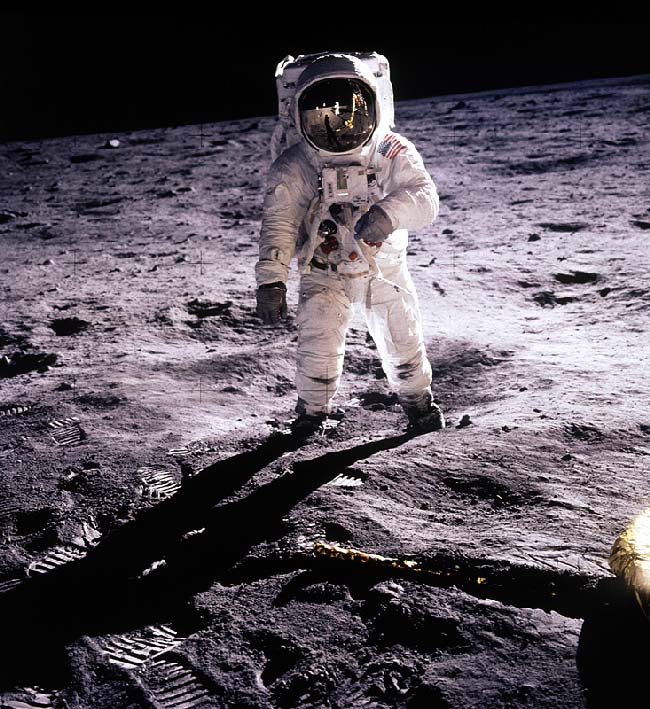Space Program, Going in Circles, Needs Bold Moves

Among the greatest accomplishments in human history was the Apollo 11 moon landing 40 years ago today, when Neil Armstrong made the first footprints on another world.
It's no secret that the space program has done little but go in circles since.
The inability or unwillingness to go boldly beyond the moon (or even back to the moon) is not all NASA's fault, of course. U.S. public appetite for TV coverage of moon missions waned even as other Apollo crews went up there. Presidents have told NASA to plan for human missions to Mars, but the space agency's budget isn't even close to what's needed for such an ambitious project.
The stumbling blocks are an overall lack of money and motivation. Yet interest remains. In an online, self-selecting SPACE.com poll, 83 percent of 6,917 respondents (as of this writing) think NASA should send astronauts back to the moon.
Four decades on, calls for bold moves — ranging from a return to the moon to heading straight for Mars — come from a broad assortment of interested folks, from the likes of Buzz Aldrin, the second guy to stick his boot in the powdery lunar soil, to Neil deGrasse Tyson, an astronomer and TV personality, to robot-guy Steve Squyres, who commands the rovers on Mars.
"I am very excited at the prospect of astronauts not just going back to the moon, but in the near future I hope, going on to explore near-Earth asteroids, going on to explore Mars and so forth," Squyres said in a recent interview.
Everyone who is anyone wants America to lead the next space race, it seems.
Sign up for the Live Science daily newsletter now
Get the world’s most fascinating discoveries delivered straight to your inbox.
'Round and 'round
Meanwhile, public interest in the space program continues to wane. Unlike the Superbowl or the Indy 500, the space race hasn't given us a big game for a long, long time. How can the public be excited by shuttle and a space station that circle Earth with the routine regularity of Indy drivers under a caution flag?
A decade ago, when asked to name America's greatest scientific achievement of the 20th century, 18 percent of people said space exploration or the moon mission, according to a Pew Research Center survey. This year, just 12 percent said so.
Yet latent interest and even a little enthusiasm remains. A new Gallup poll finds 58 percent of Americans say the space program has brought enough benefits to justify its costs, and that figure has grown from just 41 percent in 1980.
Among those interested in the space program, the desire to go back to the moon is strong.
While the non-scientific SPACE.com poll — with more than 8 in 10 favoring a return to the moon — certainly doesn't represent a cross-section U.S. residents, it suggests that those who follow the space program are eager for a jumpstart.
Another SPACE.com poll asked about the controversial issue of whether NASA should invest in human spaceflight at all, or send robots instead. Some 48 percent of 1,254 respondents said put the money into human spaceflight, while 33 percent said spend it on robots. Nineteen percent preferred to split funds evenly.
But can NASA lead the way?
Great expectations
As the astronomer Tyson points out, even if NASA wants to go boldly, funding has not been made available.
"Either the portfolio must be tuned down or the budget is raised, or both," Tyson said. "But something has to happen for NASA to go places."
In a third SPACE.com poll, also self-selecting, 53 percent of 1,440 respondents said NASA must lead the way. But 41 percent said private enterprise should take a lead role in human spaceflight.
Many think a cooperative effort — NASA and the space agencies of China, India, Japan, Europe and elsewhere — should drive the next round of human spaceflight. Aldrin, for one, envisions NASA essentially bypassing the moon and forging ahead to Mars and then beyond.
"While the international explorers, with our help, are going to the moon, we can develop the long-duration life support systems for other things," Aldrin said in a recent interview. "Flying by a comet, visiting an asteroid and station-keeping with it."
"The next moon landings should be a combined effort of all interested parties, for the good of all," wrote a commenter to the SPACE.com poll.
At a time of great national and global challenges, that sounds like bold yet reasonable thinking.
In The Water Cooler, Imaginova's Editorial Director Robert Roy Britt looks at what people are talking about in the world of science and beyond. Find more in the archives and on Twitter.
Robert is an independent health and science journalist and writer based in Phoenix, Arizona. He is a former editor-in-chief of Live Science with over 20 years of experience as a reporter and editor. He has worked on websites such as Space.com and Tom's Guide, and is a contributor on Medium, covering how we age and how to optimize the mind and body through time. He has a journalism degree from Humboldt State University in California.










